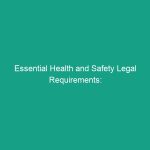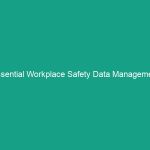Introduction
Good morning team,
Today, we will discuss an essential topic that significantly impacts our health and Safety: Essential Air Quality Monitoring: Breathe Safely in Confined Spaces. As you know, many of our tasks involve working in confined spaces, where air quality can be compromised. Understanding air quality monitoring is crucial not just for compliance but for ensuring that we create a safe working Environment for everyone.
So, why is this topic important? Poor air quality can lead to serious health issues and can impair our ability to perform tasks safely. Let’s delve deeper into understanding air quality monitoring and how we can breathe safely while working in confined spaces.
Understanding Essential Air Quality Monitoring
Air quality monitoring involves measuring the levels of pollutants, gases, and other harmful substances in the air we breathe, particularly in confined spaces. These spaces can include tanks, silos, tunnels, or any enclosed areas where air circulation is limited.
The importance of air quality monitoring cannot be overstated. Poor air quality can lead to serious health risks, including respiratory issues, headaches, dizziness, and in severe cases, it can be life-threatening. By actively monitoring air quality, we can ensure that the atmosphere is safe for all employees.
Many people believe that air quality is only an issue in industrial settings, but this misconception can lead to dangerous situations. In reality, even seemingly harmless environments can harbor hazardous air conditions.
Key Hazards, Risks, and Safety Considerations
When working in confined spaces, there are specific Hazards and risks that we must be aware of:
- Oxygen Deficiency: Normal air contains about 21% oxygen. In confined spaces, oxygen levels can drop due to various factors, making it critical to monitor this element.
- Flammable Gases: Many confined spaces may contain flammable gases that can ignite and cause explosions.
- Toxic Gases: Substances like carbon monoxide or Hydrogen Sulfide can be present and pose severe health risks.
- Particulate Matter: Dust and other particulates can lead to respiratory issues over time.
Ignoring these risks can lead to dire consequences, including accidents, injuries, and even fatalities. It’s vital to recognize that the environment in confined spaces can change rapidly, and proactive monitoring is essential.
Best Practices, Procedures, & Actionable Advice
To ensure safety when working in confined spaces, here are some Best Practices and Procedures to follow:
1. Conduct Air Quality Assessments
Before entering a confined space, always conduct a thorough air quality assessment. Use calibrated monitoring equipment to measure:
- Oxygen levels
- Concentration of toxic gases
- Presence of flammable gases
2. Implement a Permit System
A confined space entry permit system ensures that all safety checks are completed before anyone enters the space. This system should include:
- Verification of air quality monitoring results
- Identification of potential hazards
- Emergency response procedures
3. Use Proper Personal Protective Equipment (PPE)
Ensure that all employees entering a confined space are equipped with the appropriate PPE, which may include:
- Respirators or masks
- Protective clothing
- Eye protection
4. Continuous Monitoring
During the work process, continuously monitor air quality. Utilize portable monitoring devices that provide real-time data on air quality conditions. This practice allows for immediate action if air quality deteriorates.
5. Train Employees
Regular Training is vital. Ensure all employees understand:
- How to use monitoring equipment
- The signs of poor air quality
- Emergency procedures
Using real-life case studies can help illustrate the importance of these practices. For example, in a recent incident at a manufacturing plant, failure to monitor air quality resulted in multiple employees experiencing severe respiratory issues. This incident could have been prevented with proper monitoring and adherence to safety protocols.
Regulations, Standards, and Compliance
Compliance with safety Standards is not just about avoiding penalties; it is about protecting lives. Here are some key Regulations and standards relevant to air quality monitoring:
- OSHA Standards: The Occupational Safety and Health Administration outlines specific regulations regarding air quality in confined spaces.
- ISO Standards: The International Organization for Standardization provides guidelines for air quality management.
- Company Safety Policies: Ensure you are familiar with and adhere to your company’s specific safety procedures and protocols.
Understanding and implementing these regulations is critical to ensuring a safe work environment. Compliance protects not only the employees but also the organization from legal repercussions.
Employee Engagement & Discussion
Now, I want to hear from you. What safety challenges have you encountered related to air quality monitoring? Have you ever experienced a situation where poor air quality affected your work? Your insights are invaluable in shaping our safety practices.
Feel free to share your thoughts or ask questions as we continue to foster a culture of safety together.
Conclusion & Key Takeaways
In summary, essential air quality monitoring is crucial for ensuring safety in confined spaces. Remember the following key points:
- Conduct thorough air quality assessments before entering confined spaces.
- Implement a permit system for confined space entry.
- Use proper PPE and continuously monitor air quality.
- Stay informed about regulations and compliance standards.
By prioritizing these practices, we can significantly reduce health risks and create a safer working environment. Thank you for your attention and for your commitment to safety. Let’s make sure we all breathe safely while doing our jobs!


